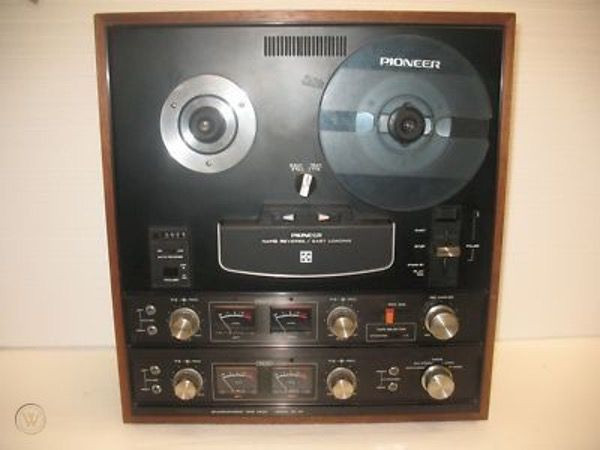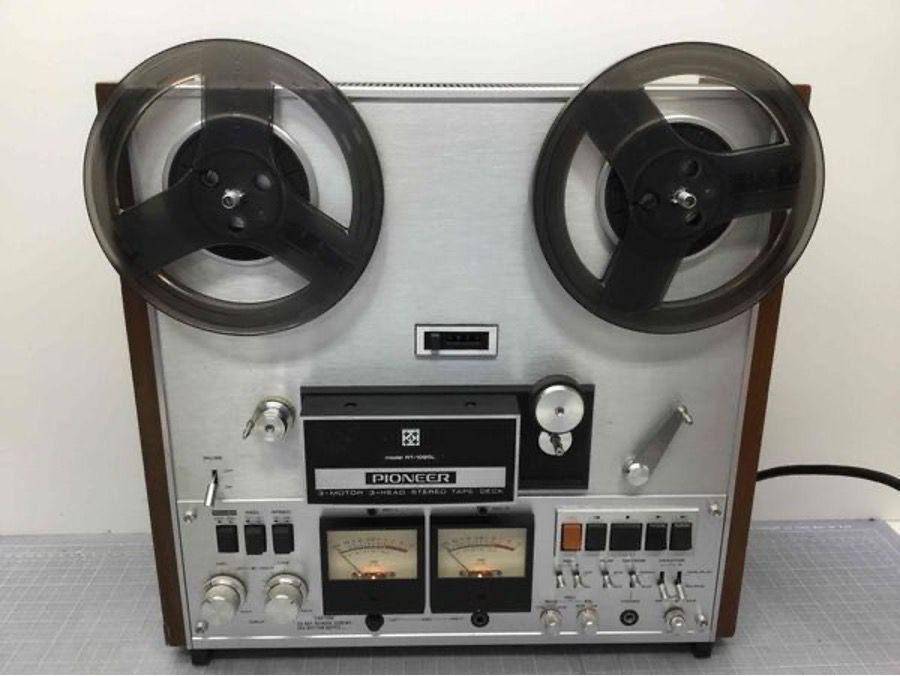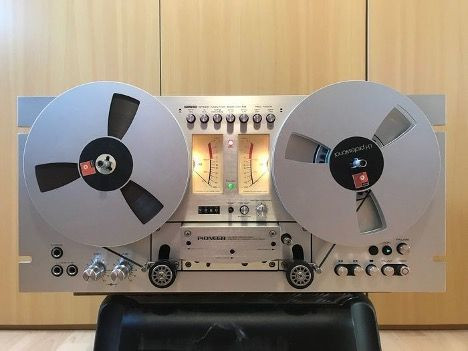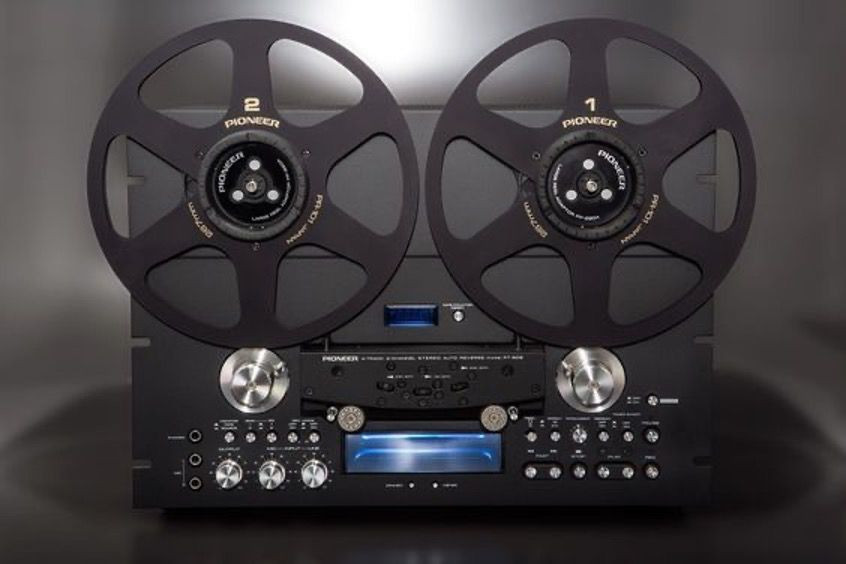Pioneer, a name synonymous with quality audio equipment, ventured into the reel-to-reel tape deck market after establishing its reputation with receivers and amplifiers. While their tube receivers and amplifiers from earlier eras are highly sought after, commanding premium prices in excellent condition, it’s their reel-to-reel tape decks that represent a fascinating chapter in vintage audio history. The robustly built 1970s Pioneer SX series receivers are legendary, but the story of Pioneer Reel To Reel machines is equally compelling, albeit less widely known.
While the peak sales for most Pioneer models were in the mid-1970s, some earlier 7-inch machines existed, including single-direction and auto-reverse models. These pioneering efforts included the T-115, the T-6600 auto-reverse model, and the QT-74, an auto-reverse stereo/single-direction quadraphonic deck. Like many late 1960s decks, these early Pioneer models could be temperamental, often plagued with braking and transport issues. Due to reliability concerns, some have unfortunately been scrapped over time. However, when functioning correctly and equipped with good heads, these early Pioneer reel to reel decks could achieve a respectable 20kHz frequency response at 7½ IPS (inches per second).
 Pioneer T-6600 Reel to Reel Tape Deck
Pioneer T-6600 Reel to Reel Tape Deck
Model T-6600 – A glimpse into early Pioneer reel to reel design.
The Rise of the RT Series Pioneer Reel to Reel
The later Pioneer reel to reel models, particularly the RT series, gained significantly more popularity. Models like the RT-1020, RT-1011, and RT-1050, all designed for 10-inch reels, became highly regarded in the consumer and semi-professional markets.
The RT-1011 served as the entry-level 10-inch deck in this series. It featured two speeds (3¾ and 7½ IPS) and standard 4-track recording and playback, catering to the prevalent consumer tape formats of the time. For enthusiasts seeking a solid and straightforward Pioneer reel to reel experience, the RT-1011 was a reliable choice.
Stepping up from the RT-1011, the RT-1020 shared similar styling but offered an enhanced feature set. The key addition was a 4-channel playback head, enabling quadraphonic sound reproduction. While recording remained in stereo, the RT-1020 provided users with the ability to enjoy the immersive experience of quadraphonic tapes, showcasing Pioneer’s commitment to evolving audio technologies in their reel to reel lineup.
 Pioneer RT-1020 Reel to Reel Tape Deck
Pioneer RT-1020 Reel to Reel Tape Deck
Pioneer RT-1020 – Popular for its quadraphonic playback capability.
The RT-1050 distinguished itself as Pioneer’s foray into the semi-professional market within their reel to reel offerings. This ½ track model boasted high-speed operation at 7½ and 15 IPS. Despite utilizing RCA input and output jacks, commonly found in consumer equipment, the RT-1050 aimed to compete with established semi-pro brands like Teac/Tascam, Otari, and Fostex. Although sales figures were not as high as some other models, the RT-1050 remains a notable example of Pioneer reel to reel technology pushing towards higher fidelity and professional applications.
Strengths of the Early RT Series Pioneer Reel to Reel Decks
These early RT series Pioneer reel to reel decks possessed several notable strengths:
- Robust 3-Motor Direct Drive: Employing a 3-motor design with direct drive reel motors ensured reliable operation. While drive belts for the capstan motor and counter were prone to degradation, they were easily replaceable, minimizing downtime and maintenance complexity for Pioneer reel to reel users.
- Excellent Sound Quality: When equipped with heads exhibiting minimal wear, these decks delivered impressive sound reproduction. Their sonic performance made them a desirable option for audiophiles seeking a high-fidelity reel to reel experience.
- Durability and Longevity: The robustness of these decks is evidenced by the number encountered with significantly worn heads. This indicated extensive use over the years, a testament to their durability. Fortunately, the steel heads could often be lapped or replaced, extending the lifespan of these Pioneer reel to reel machines.
- No-Frills 10-inch Performance: For users seeking a straightforward and dependable 10-inch reel to reel deck without unnecessary complexity, the early RT series offered a compelling and practical solution.
Weaknesses of the Early RT Series Pioneer Reel to Reel Decks
However, these early RT series Pioneer reel to reel decks were not without their weaknesses:
- Problematic Transistors: Similar to Akai decks known for their 2SC458 transistors, these Pioneer models were plagued by failure-prone 2SC1344 transistors. These transistors were prone to causing distortion or intermittent channel dropouts. Replacing all of them became a standard service procedure for technicians working on these Pioneer reel to reel units.
- Head Wear and Grooving: The standard steel heads, while durable, were susceptible to groove formation with regular use. This wear could lead to a drop in high-frequency response as the tape interacted with the grooves, impacting the overall sound quality of the Pioneer reel to reel playback. Head lapping became a common remedy to restore performance.
- Microswitch Failures: The microswitches behind the function buttons, particularly the ‘play’ button, were prone to failure. The relatively high current passing through these switches caused arcing, pitting, and eventual failure over time. Finding exact replacements often required sourcing them from eBay, highlighting a potential maintenance challenge for Pioneer reel to reel owners.
- Function Switch Locking Mechanisms: Corrosion and seizing of the function switch locking mechanisms were occasionally observed. This could result in buttons sticking or the stop button becoming permanently engaged. While disassembly and lubrication could usually resolve these issues, accessing the switch PC board was a somewhat involved process in these Pioneer reel to reel decks.
The Pioneer RT-701 and RT-707: Rack-Mountable Reel to Reel Style
Pioneer introduced four silver (and a rare black finish) rack-mountable reel to reel models, expanding their appeal to enthusiasts with rack-based stereo systems. These included the RT-701, a single-direction 7-inch deck, the RT-707 auto-reverse version, and the RT-901 and RT-909, which accommodated up to 10-inch reels and also came in single and auto-reverse configurations. Due to their popularity, the RT-701 and RT-707 deserve individual attention within the Pioneer reel to reel story.
Designed to be integrated into Pioneer’s high-end ‘Spec’ series racks, these decks offered a visually appealing and sonically capable reel to reel option. While ventilation within fully loaded racks could be limited, the aesthetic appeal of these Pioneer reel to reel units in a rack system was undeniable. Their standard 19-inch rack compatibility also allowed them to fit into various other rack systems, enhancing their versatility and ‘cool’ factor.
Despite their similar external appearance, the internal design of the 701/707 and 901/909 series Pioneer reel to reel decks differed significantly. The 707 utilized a direct-drive capstan motor, which proved to be generally reliable. The reel motors were also direct drive, contributing to stable and precise tape handling in these Pioneer reel to reel machines.
Like other Pioneer reel to reel decks of the era, the 701/707 series employed standard steel heads. Many units required head lapping due to wear-induced grooves, which could cause level fluctuations and impact sound quality. Regular maintenance, including head care, was important for optimal performance of these Pioneer reel to reel units.

Pioneer 701/707 Reel to Reel Decks – Rack-mountable and stylish.
Pioneer’s pinch roller rubber and belts in the 701/707 were known to degrade over time. Pinch rollers could also seize due to accumulated residue on the roller shafts. This could lead to speed inconsistencies or wow and flutter during recording and playback. Fortunately, cleaning and re-lubricating the pinch roller mechanism was a relatively straightforward maintenance task for Pioneer reel to reel owners.
Strengths of the Pioneer 701/707 Reel to Reel Series:
- Reliability and Sound Quality: Generally reliable and good-sounding decks, the 701/707 series offered a solid Pioneer reel to reel experience.
- High-End Choice: A great option as a high-end deck, available in both single-direction (701) and auto-reverse (707) configurations, catering to different user preferences within the Pioneer reel to reel market.
- Ease of Servicing: Typically easy to service with relatively few electronic problems, making maintenance less daunting for technicians and experienced Pioneer reel to reel enthusiasts.
- Reliable Motors: Motors generally proved to be reliable, contributing to the overall longevity and dependable operation of these Pioneer reel to reel decks.
Weaknesses of the Pioneer 701/707 Reel to Reel Series:
- Rubber Component Degradation: Bad rubber components were a known issue. Original pinch rollers typically required replacement, along with the counter belt, as these rubber parts aged and deteriorated in these Pioneer reel to reel machines.
- Pinch Roller Bearing Gumming: Pinch roller bearings were prone to gumming up, but cleaning and relubrication was a relatively easy fix, a common maintenance point for Pioneer reel to reel owners.
- Forward/Reverse Light Burnout (707): The forward/reverse indicator lights on the RT-707 were prone to burning out. Many users opted to replace them with more durable LED lights, a popular modification in the Pioneer reel to reel community.
Pioneer RT-901 and RT-909: The Pinnacle of Pioneer Reel to Reel
The RT-909 represented the top-of-the-line Pioneer reel to reel offering and was the most popular 10-inch model from Pioneer. It shared the attractive aesthetics of the 701/707 series but with an even greater visual impact, particularly when paired with the sought-after 10-inch Pioneer reels (which now fetch premium prices on platforms like eBay).
The RT-901 and 909 series Pioneer reel to reel decks differed significantly in their internal components from the 70X series. The design and construction were more complex, incorporating more logic circuitry via a PC board behind the function buttons. The transport board was also more intricate, utilizing trimpots for tape tension adjustment instead of the large power resistors found in the 70X series Pioneer reel to reel decks.
The motor in the 90X series was a smaller 24-volt motor, the same model used by Teac in many of their decks. The 90X series featured a dual capstan drive, a step up from the single capstan design of the 70X series. Using the correct capstan belt with the precise thickness and diameter was crucial for proper operation. Incorrect belt specifications, sometimes found in cross-reference guides, could lead to tape drooping and tension issues, a troubleshooting challenge for Pioneer reel to reel technicians.
The motors in the 90X series had brushes that were subject to wear from heavy use. Consequently, the price of replacement motors on eBay increased significantly in recent years. If the capstan belt stretched and wrapped around the motor pulley, it could cause the motor to stall and burn out within seconds, highlighting a potential vulnerability if maintenance was neglected on these Pioneer reel to reel decks.
Troubleshooting the logic board and tape transport board in the 90X series could be challenging, as was diagnosing issues with the fluorescent meter logic board, which utilized TTL-based circuits. A fault in a single chip could affect the entire display. While replacement boards could often be found on eBay, removing and reinstalling the logic board was a particularly complex task in these high-end Pioneer reel to reel machines.
Despite these complexities, when properly serviced and maintained, and with heads in good condition, the RT-90X series Pioneer reel to reel decks were a prized addition to any vintage stereo system, delivering stellar performance and iconic aesthetics.
 Rare Black Pioneer RT-909 Reel to Reel Deck
Rare Black Pioneer RT-909 Reel to Reel Deck
The super rare black RT-909 deck, a highly collectible Pioneer reel to reel.
Strengths of the Pioneer RT-90X Reel to Reel Series:
- High-End Performance and Reliability: A generally reliable, high-end deck capable of exceptional audio performance, representing the pinnacle of Pioneer reel to reel technology.
- Iconic Aesthetics: The ‘coolness’ factor of the blue fluorescent VU meter display, matching other Pioneer products of the era, contributed to their desirability and visual appeal in a Pioneer reel to reel setup.
Weaknesses of the Pioneer 90x Reel to Reel Series:
- Capstan Motor Vulnerability: Bad belts and degraded pinch roller rubber could potentially damage or destroy the capstan motor if not replaced promptly, requiring careful maintenance of these Pioneer reel to reel units.
- Capstan Motor Weakness: Capstan motors were considered somewhat weak compared to other components, making them a potential point of failure with age and heavy use in these Pioneer reel to reel decks.
- Tape Tension Lever Seizing: Tape tension levers could seize due to degraded grease, requiring cleaning and relubrication as part of routine maintenance for Pioneer reel to reel owners.
- Steel Head Wear: Steel heads were still susceptible to wear with continuous use, necessitating head lapping or replacement to maintain optimal sound quality in these Pioneer reel to reel machines.
- Complex Logic and VU Meter Boards: Logic and VU meter PC boards could be difficult to troubleshoot, requiring specialized knowledge and tools for repair of these advanced Pioneer reel to reel decks.
- End-of-Tape Microswitch Failures: End-of-tape microswitches could fail due to corrosion and wear, although replacement was relatively straightforward, it was still a potential point of failure in these Pioneer reel to reel units.
Pioneer RT-2022 and RT-2044: Semi-Professional and Portable Pioneer Reel to Reel
The RT-2022 and RT-2044 models represent a less common chapter in the Pioneer reel to reel story. Based on the RT-1050 models, these decks were offered in ½ track (RT-2022) or 4 track (4 channel – RT-2044) configurations. The transport mechanism was as reliable as other RT 10XX models, and they operated at high speeds (7½ and 15 IPS). These models were Pioneer’s attempt to penetrate the semi-professional market and also to offer a ‘portable’ high-end reel to reel solution. They came with deck covers that snapped onto the front of the transport and electronics sections, along with carrying handles.
The electronics of the RT-2022/2044 featured front panel bias and EQ adjustments, along with microphone and line mixing capabilities. These were well-featured decks, but finding intact front covers is rare due to their pressboard construction, which made them prone to cracking and splitting if handled roughly. The heads were similar to the 10XX series, resulting in comparable sound quality to the rest of the Pioneer reel to reel line.
A significant weakness of these models was the specialized cables connecting the preamplifier units to the transport. These multi-pin cables were difficult to replace if lost, as the connectors were no longer in production. Interestingly, early Sony reel-to-reel video recorders used similar connectors between the decks and video monitors, suggesting a potential, albeit challenging, source for replacement parts for these Pioneer reel to reel decks.
 Pioneer RT-2022 Reel to Reel Deck
Pioneer RT-2022 Reel to Reel Deck
Pioneer RT-2022 deck – A rare semi-pro and portable Pioneer reel to reel offering.
Conclusion:
Pioneer’s journey into reel to reel tape deck technology yielded a diverse range of models, from early consumer units to high-end, semi-professional machines. While some models had their quirks and weaknesses, particularly related to aging components, the Pioneer reel to reel legacy is marked by robust build quality, generally excellent sound, and iconic designs. For vintage audio enthusiasts and collectors, Pioneer reel to reel decks remain a compelling and rewarding area to explore, offering a blend of performance, aesthetics, and a tangible connection to the golden age of tape recording.

